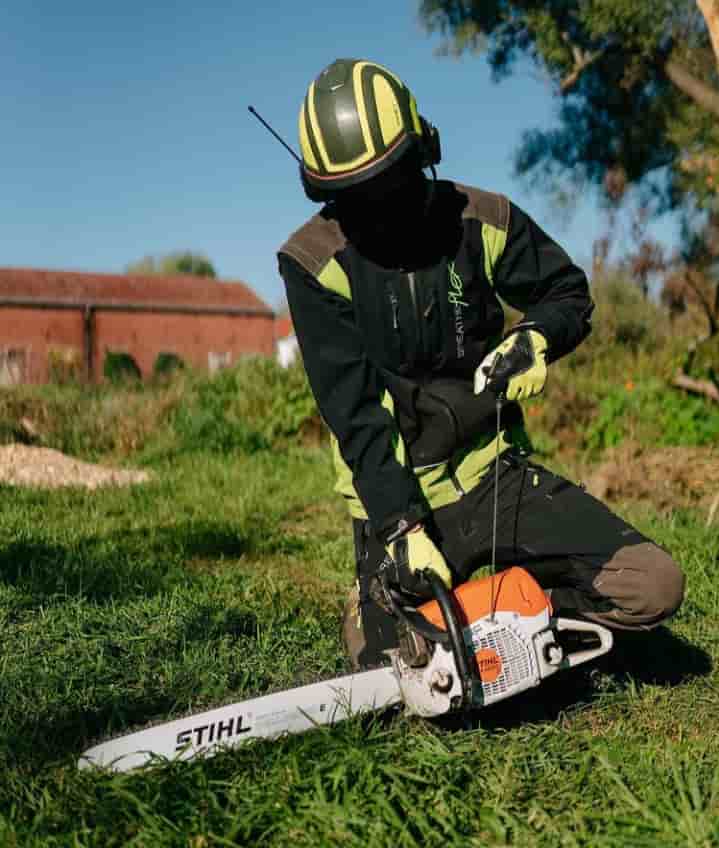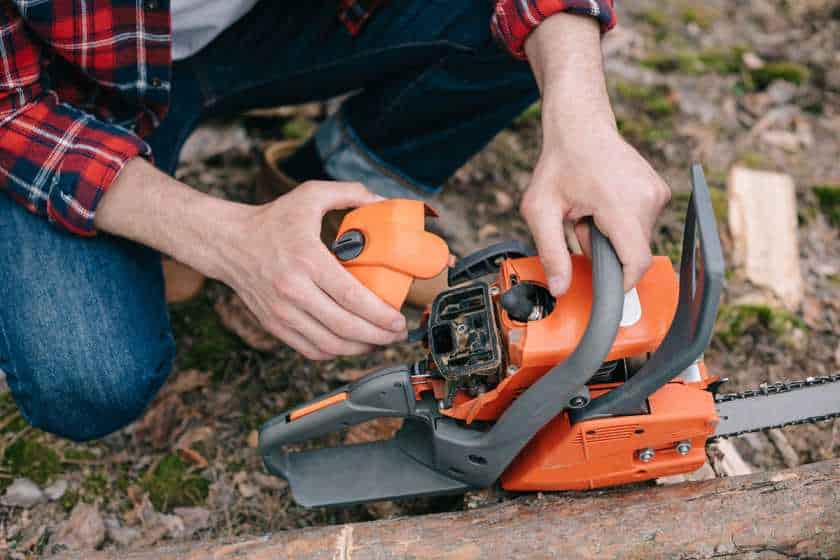Chainsaws are a dangerous tool, and they need to be cared for with caution.
If the your chainsaw is not starting, there could be a number of issues causing it.
In this article, we will discuss some of the common reasons why chainsaws won’t start and provide tips on how to troubleshoot and fix them.
So, Let’s get started!
Table of Contents
6 Tricks to Fix Your Chainsaw That Won’t start
Chainsaws are one of the most important tools in a homeowner’s arsenal, but like any tool, they can be unreliable. Here are six tricks to help fix a chainsaw that won’t start.

1. Check the carburetor
If your chainsaw won’t start, check the carburetor. If the gas is flowing properly and the spark plug is sparking, the carburetor may be faulty. If the carburetor is faulty, it can cause the engine to not start. In some cases, a defective carburetor may just need a new fuel filter, while in other cases it may need to be replaced entirely.
2. Clean the chain and sharpener
The chain on your chainsaw becomes dirty and needs sharpening. If you don’t clean the chain and sharpener, the dirt and metal will build up over time. This will make it harder to sharpen the chain, and the bike may not run as smoothly. Here are instructions for cleaning the chain and sharpener:
3. Disassemble the chainsaw and check all parts for wear or damage
When chainsawing, it is important to take care of the equipment and keep it in good working order. One way to do this is to disassemble the chainsaw and check all parts for wear or damage. Identifying and addressing performance issues as soon as possible can prevent significant damage.
4. Check the fuel supply
If your car isn’t starting, it might not have enough fuel. Make sure the car has enough fuel by checking the fuel supply.
- Check the gas tank.
- Check the gauge on the dashboard.
- Check the level in the filler tube.
- Check for stale or low fuel in the engine compartment.
5. Remove any obstructions from the spark plug hole
A chainsaw with a properly functioning spark plug will produce an even, consistent cut. However, if the spark plug hole is blocked, the chain will not ignite and the saw will not run correctly. By removing any obstructions from the spark plug hole, you can ensure that your chainsaw runs correctly and produces a clean cut.
6. Make sure the air filter is clean and properly installed
If you use your chainsaw regularly, it’s important to make sure the air filter is clean and properly installed. Keep in mind that an uncleaned air filter will cause your chainsaw to run less efficiently and create more emissions. An up-to-date air filter will also help keep dirt and debris out of the engine so you won’t need to deal with engine issues.
Chainsaw safety: Tips for making your chainsaw easier to start
Chainsaw safety is essential when using this tool. Follow these tips to make your chainsaw easier to start:
- Make sure the chain is properly lubricated. Oil the chain and sprocket well before every use.
- Hold the saw firmly against your body as you pull the trigger to avoid kickback.
- Keep your fingers clear of the blade while operating the saw.
- Always wear protective eyewear when using a chainsaw, even if you’re only cutting thin pieces of wood.
- Keep the chain sharp by regularly sharpening it on a chain-sharpening tool or with a chainsaw blade sharpener kit (available at hardware stores).
How do I make my chainsaw easier to start?
Chainsawing can be a daunting task for the uninitiated, but with some easy tips and tricks, it can be made much easier. Here are a few tips to help make your chainsaw start easier:
1. Make sure the chain is properly lubricated. This will help prevent binding and ensure that your saw starts easily each time.
2. Keep the chain sharp by regularly sharpening the blade using a chainsaw sharpener. Dull blades are more difficult to start and can cause damage to your machine if they are not treated promptly.
3. Keep the saw clean by washing off any debris after use and storing it in a clean place away from moisture and dust particles.
4. Replace the blade as needed. NOTE: When you purchase a new saw, make sure to use only the proper type of blade for your model.
5. Never remove or replace the back cover of the saw or use any other tools to modify its operation.
What causes chainsaws to stop working?

Many people think that chain saws will stop working if the chain becomes too dull. However, this isn’t always the case. Here are eight common reasons why a chainsaw may not be cutting properly:
- The chain is worn out or stretched out.
- The chain is dirty and doesn’t allow the saw to rotate freely.
- The debris littering the saw’s path was obstructing it.
- The bar has been bent or twisted, preventing it from spinning freely.
- The spark plug is faulty and needs to be replaced.
- The fuel supply line has become plugged with debris or sand.
- The fuel filter is clogged or clogged with debris or sand.
- The supply hose has become disconnected from the fuel rail.
Why will the My chainsaw start but not run?
When you try to start your chainsaw, it sometimes won’t run. There could be a few reasons why this might be the case. Here are a few of the most common:
- The chain is off-center
- The oil isn’t level or clean
- The spark plug is fouled or broken
- The fuel line is blocked
- The carburetor needs tuning
In order to fix these problems, you’ll need to take apart the chainsaw and check each part for proper function. If one of these parts is not working right, the status of the chainsaw will be compromised.
How do you start a chainsaw after sitting?
Chainsaw startup can be a daunting task, even for experienced users. Proper chain tensioning is essential to maintaining proper saw operation and preventing damage to the machine. Here are some tips to help get your chainsaw started after sitting:
– Make sure the choke is fully open and that the blade is properly sharpened. Choking the engine won’t do any good if the chain isn’t sharp.
– Position yourself so you can easily reach the flywheel wheel and clutch assembly. Gripping these parts with both hands can help prevent unintentional starts.
– Pull down on the starting handle until it locks into position, then release it quickly. The recoil from firing will start the engine.
– Keep your hand close to the spark plug while starting; an electric starter can be very dangerous if not handled correctly.
Chainsaw safety is important – no matter how often you use your chainsaw. Follow these tips to make your chainsaw easier to start:
– Keep the chain sharp and free from defects. Correcting the kinks and nicks in a chain is a good way to evaluate the quality of your bracelet.
– Check the tension on the chain before each use. Over-tensioning can wear out the chain and cause it to break.
– Be sure you maintain a firm grip on the handle while operating your chainsaw. This will help prevent loss of control and accidents.
– Be aware of potential hazards around your chainsaw – such as trees with low branches or logs that may fall when cut. Stay clear of these areas!

